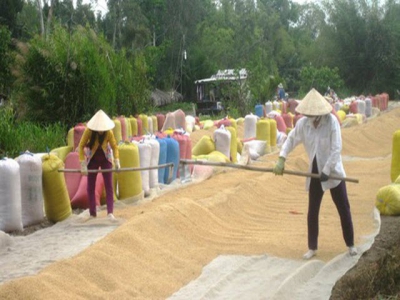Mekong Delta provinces expect good summer-autumn rice crop

Amid saltwater intrusion and drought, Mekong Delta provinces still managed to maintain paddy production at 10.7 million tons, merely down around 118,000 tons. This is an impressive effort of farmers and local authorities, hereby, helping to ensure food security.
Mr. Quach Van Ngoan, a farmer in Long Binh Commune in Long My Town in Hau Giang Province, said that his family has 4,000 square meters of rice. He finished harvesting and already sold all his paddy more than 10 days ago for VND5,200 per kilogram as farmers needed money to cover necessary expenses and daily expenses.
Farmers in the Mekong Delta have mostly finished harvesting the winter-spring rice crop. Most farmers harvested and sold paddy when the prices were at high levels. Currently, paddy is in warehouses of export enterprises, rice mills, and traders. Enterprises need to export rice in a certain volume. In the past weeks, arguments were raised on social networks and some media on keeping or suspending the export of rice. It is important to consider and calculate the volume and time of export.
According to a report by the Vietnam Food Association, by March 27 this year, the total amount of undelivered signed contracts was nearly 1.6 million tons of rice. Of which, the volume of rice that must be delivered from now to May 31 is nearly 1.4 million tons of rice. The available amount of rice in its members’ warehouses is 1.65 million tons. If including non-member enterprises, the amount of undelivered signed contracts is nearly 1.67 million tons of rice. Based on the review result and the opinions of provinces in the Mekong Delta and enterprises, the Ministry of Industry and Trade will report with the Prime Minister the plan to regulate the export of rice soon.
However, farmers in many provinces in the Mekong Delta have been going through an ironic reality in which, after selling all their paddy, they buy rice from local markets, instead of stockpiling paddy in their houses like before. Currently, the supply of rice at supermarkets and markets is plentiful. However, amid the context that the country is struggling to control the Covid-19 outbreak, provinces also need to actively hold the sources of supply in food companies, large rice mills, and traders to take initiative in providing rice for the distribution network from urban to rural markets, preventing a shortage of rice.
The impacts of the Covid-19 pandemic might be difficult to end in a short time so the effort to control the disease and maintain agricultural production is extremely important. Therefore, provinces and the agricultural sector need to instruct drastically, timely support people in difficult areas affected by saltwater intrusion and drought to cultivate the summer-autumn rice crop as soon as possible. Provinces in the Mekong Delta will sow around 1.5 million hectares of rice, aiming to collect 8.7 million tons of paddy. Rice cultivation will be in April and May. According to the Ministry of Agriculture and Rural Development (MARD), this year, the Mekong Delta will produce more than 4 million hectares of rice in three rice crops and might reach a production of around 24.3 million tons.
Mr. Le Tien Chau, Chairman of the People’s Committee of Hau Giang Province, said that the province has implemented and requested the agricultural sector to multiply the smart rice cultivation model. At present, the agricultural sector is monitoring the salinity level to inform farmers timely for them to be proactive in rice production.
The MARD analyzed that the damaged areas of winter-spring rice crop were insignificant thanks to the instruction to grow rice early. Besides, farmers had a good harvest of the winter-spring rice crop with an average rice yield of nearly 7 tons per hectare so the losses caused by saltwater intrusion and drought were covered. Rice production is expected to be the same as last year. The ministry forecast that the domestic consumption demand for rice included stockpiling is 29.96 million tons of paddy. Particularly, people’s consumption is 14.26 million tons; 7.5 million tons are for processing; 3.4 million tons for livestock production; 1 million tons are used as seeds; 3.8 million tons are for domestic reserves. Thus, there are around 13.5 million tons of paddy left, or 6.5-6.7 million tons of rice. If solutions to prevent saltwater intrusion and drought are carried out effectively, the summer-autumn rice crop will achieve a good production.
Related news
 MoIT proposes to resume rice exports
MoIT proposes to resume rice exports The Ministry of Industry and Trade (MoIT) has asked the Government to resume rice exports. However, the export volume would be limited at 800,000 tonnes
 Coronavirus hits Vietnam’s fruit exports to biggest market, China
Coronavirus hits Vietnam’s fruit exports to biggest market, China Fruits exports to China in the first quarter fell 29.4 percent year-on-year as the coronavirus pandemic halted trade activities.
 Mekong Delta farmers switch to other crops in response to climate change
Mekong Delta farmers switch to other crops in response to climate change More farmers in the Mekong Delta have restructured their crop cultivation to adapt to the effects of climate change.